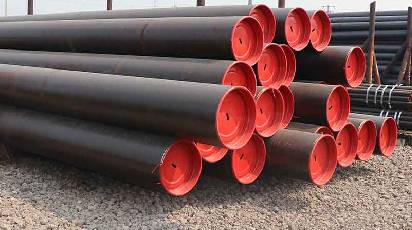Seamless steel tubes have a wide range of uses. General purpose seamless steel tubes are rolled from ordinary carbon structural steel, low-alloy structural steel or alloy structural steel, with a large output, and are mainly used as pipelines or structural parts for transporting fluids. 2 It is divided into three types according to the application: a. Supply according to chemical composition and mechanical properties; b. Supply according to mechanical properties; C, Supply according to hydraulic test. Steel pipes supplied according to categories a and b are also subjected to hydraulic tests if they are used to withstand fluid movement. 3. Special-purpose seamless tubes include boiler seamless tubes, geological seamless steel tubes and petroleum seamless tubes.
Weld steel pipe is also called welded pipe, which is a steel pipe made of steel plate or steel strip after welding. The production process of welded steel pipe is simple, the production efficiency is high, there are many varieties and specifications, and the equipment cost is small, but the general strength is lower than that of seamless steel pipe. Since the 1930s, with the rapid development of high-quality strip continuous rolling production and the improvement of welding and inspection technology, the quality of welds has continuously improved, and the variety and specifications of welded steel pipes have increased, and they have replaced Seam steel pipe.
Welded steel pipe is divided into straight seam welded pipe and spiral welded pipe according to the form of weld. The production process of straight seam welded pipe is simple, high production efficiency, low cost and rapid development. The strength of spiral welded pipes is generally higher than that of straight seam welded pipes. Welded pipes with larger diameters can be produced from narrower billets. Welded pipes with different diameters can also be produced with billets of the same width. However, compared with the straight seam pipe of the same length, the weld seam length is increased by 30 ~ 100%, and the rent production speed is lower. Therefore, the smaller-diameter welded pipes are mostly straight seam welded, while the large-diameter welded pipes are mostly spiral welded.

Seamless Steel Tube
Standard cleaning procedure for seamless steel tubes
1. Cleaning of seamless steel tube
Use solvents and emulsions to clean the surface of wear-resistant pipes, wear-resistant ceramic pipes, ceramic pipes, and ceramic composite pipes to remove oil, grease, dust, lubricants and similar organic matter, but it cannot remove rust, scale, Welding flux, etc., is therefore only used as an auxiliary means in anti-corrosion production.
2. Tools for rust removal of seamless steel pipes
Tools such as wire brushes are mainly used to polish the surface of steel materials to remove loose or raised oxide scale, rust, welding slag, etc. The rust removal of manual tools can reach Sa2 level, and the rust removal of power tools can reach Sa3 level. If the steel surface is firmly attached to the iron oxide scale, the rust removal effect of the tool is not ideal, and it cannot reach the depth of anchor pattern required for anticorrosion construction.
3. Pickling of seamless steel pipes
Generally, chemical and electrolytic methods are used for pickling. Wear-resistant pipes, wear-resistant ceramic pipes, ceramic pipes, and ceramic composite pipes are only treated by chemical pickling, which can remove scale, rust, and old coatings. Reprocessing after sandblasting and rust removal. Although chemical cleaning can make the surface reach a certain degree of cleanliness and roughness, its anchor pattern is shallow and it is easy to cause pollution to the environment.
